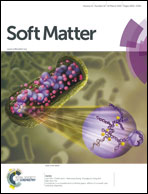Structural studies of the lamellar to bicontinuous gyroid cubic (Q GII) phase transitions under limited hydration conditions†
Abstract
Non-equilibrium pathways of lyotropic phase transitions such as the lamellar to inverse bicontinuous cubic phase transition are important dynamical processes resembling cellular fusion and fission processes which can be exploited in biotechnological processes such as drug delivery. However, utilising and optimising these structural transformations for applications require a detailed understanding of the energetic pathways which drive the phase transition. We have used the high pressure X-ray diffraction technique to probe the lamellar to QGII phase transition in limited hydration monolinolein on the millisecond time scale. Our results show that the phase transition goes via a structural intermediate and once the QGII phase initially forms the elastic energy in the bilayer drives this structure to its equilibrium lattice parameter.


 Please wait while we load your content...
Please wait while we load your content...